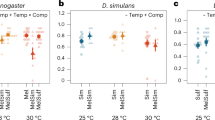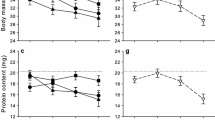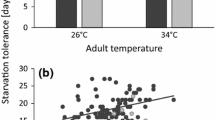Abstract
Temperature and nutrition are amongst the most influential environmental determinants of Darwinian fitness in ectotherms. Since the ongoing climate warming is known to alter nutritional environments encountered by ectotherms, a precise understanding of the integrated effects of these two factors on ectotherm performance is essential for improving the accuracy of predictions regarding how ectotherms will respond to climate warming. Here we employed response surface methodology to examine how multiple life-history traits were expressed across a grid of environmental conditions representing full combinations of six ambient temperatures (13, 18, 23, 28, 31, 33 °C) and eight dietary protein:carbohydrate ratios (P:C = 1:16, 1:8, 1:4, 1:2, 1:1, 2:1, 4:1, 8:1) in Drosophila melanogaster. Different life-history traits were maximized in different regions in the two-dimensional temperature-nutrient space. The optimal temperature and P:C ratio identified for adult lifespan (13 °C and 1:16) were lower than those for early-life female fecundity (28 °C and 4:1). Similar divergence in thermal and nutritional optima was found between body mass at adult emergence (18 °C and P:C 1:1) and the rate of pre-adult development (28 °C and P:C 4:1). Pre-adult survival was maximized over a broad range of temperature (18—28 °C) and P:C ratio (1:8–8:1). These results indicate that the occurrence of life-history trade-offs is regulated by both temperature and dietary P:C ratio. The estimated measure of fitness was maximized at 23 °C and P:C 2:1. Based on the shape of the response surface constructed for this estimated fitness, we characterized the fundamental thermal and nutritional niche for D. melanogaster with unprecedented detail.

Similar content being viewed by others
References
Angilletta MJ Jr (2009) Thermal adaptation: a theoretical and empirical synthesis. Oxford University Press, Oxford
Atkinson D (1994) Temperature and organism size: a biological law for ectotherms? Adv Ecol Res 25:1–58
Bauerfeind SS, Fischer K (2013) Increased temperature reduces herbivore host-plant quality. Glob Change Biol 19:3272–3282
Begon M, Townsend CR, Harper JL (2006) Ecology. From individuals to ecosystems. Blackwell Publishing, Oxford
Birch LC (1953) Experimental background to the study of the distribution and abundance of insects: 1. The influence of temperature, moisture and food on the innate capacity for increase of three grain beetles. Ecology 34:698–711
Blows MW, Brooks R (2003) Measuring nonlinear selection. Am Nat 162:815–820
Bochdanovits Z, de Jong G (2003) Temperature dependence of fitness components in geographical populations of Drosophila melanogaster: changing the association between size and fitness. Biol J Linn Soc 80:717–725
Boersma M, Mathew KA, Niehoff B, Schoo KL, Franco-Santos RM, Meunier CL (2016) Temperature driven changes in the diet preference of omnivorous copepods: no more meat when it’s hot? Ecol Lett 19:45–53
Carreira BM, Segurado P, Orizaola G, Goncalves N, Pinto V, Laurila A, Rebelo R (2016) Warm vegetarians? Hear waves and diet shifts in tadpoles. Ecology 97:2964–2974
Carvalho GB, Drago I, Hoxha S, Yamada R, Mahneva O, Bruce KD, Obando AS, Conti B, Ja WW (2017) The 4E-BP growth pathway regulates the effect of ambient temperature on Drosophila metabolism and lifespan. Proc Natl Acad Sci USA 114:9737–9742
Chase JM, Leibold MA (2003) Ecological niches: interspecific interactions. The University of Chicago Press, Chicago
Clancy DJ, Kennington WJ (2001) A simple method to achieve consistent larval density in bottle cultures. Drosoph Inf Serv 84:168–169
Clarke A (2017) Principles of thermal ecology. Oxford University Press, Oxford
Clissold FJ, Simpson SJ (2015) Temperature, food quality and life history traits of herbivorous insects. Curr Opin Insect Sci 11:63–70
Clissold FJ, Coggan N, Simpson SJ (2013) Insect herbivores can choose microclimates to achieve nutritional homeostasis. J Exp Biol 216:2089–2096
Coggan N, Clissold FJ, Simpson SJ (2011) Locusts use dynamic thermoregulatory behavior to optimize nutritional outcomes. Proc R Soc Lond B 278:2745–2752
Colinet H, Sinclair BJ, Vernon P, Renault D (2015) Insects in fluctuating thermal environments. Annu Rev Entomol 60:123–140
Conti B (2008) Considerations on temperature, longevity and aging. Cell Mol Life Sci 65:1626–1630
Cross WF, Hood JM, Benstead JP, Huryn Ad, Nelson D (2015) Interactions between temperature and nutrients across levels of ecological organization. Global Change Biol 21:1025–1040
David JR, Allemand R, Van Herrewege J, Cohet Y (1983) Ecophysiology: abiotic factors. In: Ashburner M, Carson HL, Thompson JN (eds) The genetics and biology of Drosophila. Academic Press, London, pp 105–170
Deutsch CA, Tewksbury JJ, Huey RB, Sheldon KS, Ghalambor CK, Haak DC, Martin PR (2008) Impacts of climate warming on terrestrial ectotherms across latitude. Proc Natl Acad Sci USA 105:6668–6672
Diamond SE, Kingsolver JG (2010) Environmental dependence of thermal reaction norms: host quality can reverse the temperature-size rule. Am Nat 175:1–10
Dillon ME, Wang G, Garrity PA, Huey RB (2009) Thermal preference in Drosophila. J Therm Biol 34:109–119
Garcia AM, Calder RB, Dolle MET, Lundell M, Kapahi P, Vijg J (2010) Age- and temperature-dependent somatic mutation accumulation in Drosophila melanogaster. PLoS Genet 6:e1000950
Gvoždik L (2018) Just what is the thermal niche? Oikos 127:1701–1710
Hawlena D, Schmitz OJ (2010) Herbivore physiological response to predation risk and implications for ecosystem nutrient dynamics. Proc Natl Acad Sci USA 107:15503–15507
Hoffmann AA (2010) Physiological climatic limits in Drosophila: patterns and implications. J Exp Biol 213:870–880
Hooper HL, Connon R, Callaghan A, Fryer G, Yarwood-Buchanan S, Biggs J, Maund SJ, Hutchinson TH, Sibly RM (2008) The ecological niche of Daphnia magna characterized using population growth rate. Ecology 89:1015–1022
Huey RB, Berrigan D (2001) Temperature, demography, and ectotherm fitness. Am Nat 158:204–210
Huey RB, Kingsolver JG (1989) Evolution of thermal sensitivity of ectotherm performance. Trends Ecol Evol 4:131–135
Huey RB, Wakefield T, Crill WD, Gilchrist GW (1995) Within- and between-generation effects of temperature on early fecundity of Drosophila melanogaster. Heredity 74:216–223
Hutchinson GE (1957) Concluding remarks. Population studies: animal ecology and demography. Cold Spring Harbor Symp Quant Biol 22:415–427
Jang T, Lee KP (2018) Comparing the impacts of macronutrients on life-history traits in larval and adult Drosophila melanogaster. The use of nutritional geometry and chemically defined diets. J Exp Biol 221:181115
Jang T, Rho MS, Koh SH, Lee KP (2015) Host-plant quality alters herbivore responses to temperature: a case study using the generalist Hyphantria cunea. Entomol Exp Appl 154:120–130
Jensen K, McClure C, Priest NK, Hunt J (2015) Sex-specific effects of protein and carbohydrate intake on reproduction but not lifespan in Drosophila melanogaster. Aging Cell 14:605–615
Kapahi P, Zid BM, Harper T, Koslover D, Sapin V, Benzer S (2004) Regulation of lifespan in Drosophila by modulation of genes in the TOR signaling pathway. Curr Biol 14:885–890
Karl I, Fischer K (2008) Why get big in the cold? Towards a solution to a life-history puzzle. Oecologia 155:215–225
Kearney M, Simpson SJ, Raubenheimer D, Helmuth B (2010) Modelling the ecological niche from functional traits. Philos Trans R Soc Lond B 365:3469–3483
Keil G, Cummings E, de Magalhaes JP (2015) Being cool: how body temperature influences ageing and longevity. Biogerontology 16:383–397
Kingsolver JG, Woods HA (1998) Interactions of temperature and dietary protein concentration in growth and feeding of Manduca sexta caterpillars. Physiol Entomol 23:354–359
Kingsolver JG, Shlichta JG, Ragland GJ, Massie KR (2006) Thermal reaction norms for caterpillar growth depend on diet. Evol Ecol Res 8:703–715
Kurtz TC, Sgrò CM, Mirth CK (2019) Interacting with change: Diet mediates how larvae respond to their thermal environment. Funct Ecol 33:1940–1951
Le Couteur DG, Solon-Biet S, Cogger VC, Mitchell SJ, Senior A, de Cabo R, Raubenheimer D, Simpson SJ (2016) The impact of low-protein high-carbohydrate diets on aging and lifespan. Cell Mol Life Sci 73:1237–1252
Lee KP (2015) Dietary protein:carbohydrate balance is a critical modulator of lifespan and reproduction in Drosophila melanogaster: a test using a chemically defined diet. J Insect Physiol 75:12–19
Lee KP, Jang T (2014) Exploring the nutritional basis of starvation resistance in Drosophila melanogaster. Funct Ecol 28:1144–1155
Lee KP, Cory JS, Wilson K, Raubenheimer D, Simpson SJ (2006) Flexible diet choice offsets protein costs of pathogen resistance in a caterpillar. Proc R Soc Lond B 273:823–829
Lee KP, Simpson SJ, Clissold FJ, Brooks RJ, Ballard WO, Taylor PW, Soran N, Raubenheimer D (2008) Lifespan and reproduction in Drosophila: new insights from nutritional geometry. Proc Natl Acad Sci USA 105:2498–2503
Lee KP, Kim JS, Min KJ (2013) Sexual dimorphism in nutrient intake and lifespan is mediated by mating in Drosophila melanogaster. Anim Behav 86:987–992
Lee KP, Jang T, Ravzanaadii N, Rho MS (2015) Macronutrient balance modulates the temperature-size rule in ectotherms. Am Nat 186:212–222
Lihoreau M, Poissonnier LA, Isabel G, Dussutour A (2016) Drosophila females trade off good nutrition with high-quality oviposition sites when choosing foods. J Exp Biol 219:2514–2524
Machovsky-Capuska GE, Senior AM, Simpson SJ, Raubenheimer D (2016) The multidimensional nutritional niche. Trends Ecol Evol 31:355–365
Mirth CK, Alves AN, Piper MDW (2019) Turning food into eggs: insights from nutritional biology and developmental physiology of Drosophila. Curr Opin Insect Sci 31:49–57
Mirzaei H, Suarez JA, Longo VD (2014) Protein and amino acid restriction, aging and disease: from yeast to humans. Trends Endocrin Metab 25:558–566
Morimoto J, Lihoreau M (2019) Quantifying nutritional trade-offs across multidimensional performance landscapes. Am Nat 193:E168–E181
Neat F, Fowler K, French V, Partridge L (1995) Thermal evolution of growth efficiency in Drosophila melanogaster. Proc R Soc Lond B 260:73–78
Nychka D, Furrer R, Paige J, Sain S (2017) Fields: tools for spatial data. R Package Version 9:6
Nylin S, Gotthard K (1998) Plasticity in life-history traits. Annu Rev Entomol 43:63–83
Paaijmans KP, Heinig RL, Seliga RA, Blanford JI, Blanford S, Murdock CC, Thomas MB (2013) Temperature variation makes ectotherms more sensitive to climate change. Glob Change Biol 19:2373–2380
Petavy F, David JR, Gilbert P, Moreteau B (2001) Viability and rate of development at different temperatures in Drosophila: a comparison of constant and alterating thermal regimes. J Therm Biol 26:29–39
R Development Core Team (2012) R: a language and environment for statistical computing. R Foundation for Statistical Computing, Vienna, Austria. https://www.R-project.org/
Rapkin J, Jensen K, Archer CR, House CM, Sakaluk SK, del Castillo E, Hunt J (2018) The geometry of nutrient space-based life-history trade-offs: sex-specific effects of macronutrient intake on the trade-off between encapsulation ability and reproductive effort in decorated crickets. Am Nat 191:452–474
Rho MS, Lee KP (2017) Temperature-driven plasticity in nutrient use and preference in an ectotherm. Oecologia 185:401–413
Rion S, Kawecki TJ (2007) Evolutionary biology of starvation resistance: what we have learned from Drosophila. J Evol Biol 20:1655–1664
Rodrigues MA, Martins NE, Balance LF, Broom LN, Dias AJS, Fernandes ASD, Rodrigues F, Sucena E, Mirth CK (2015) Drosophila melanogaster larvae make nutritional choices that minimize developmental time. J Insect Physiol 81:69–80
Roff DA (2002) Life history evolution. Sinauer Associates, Sunderland
Rosenblatt AE, Schmitz OJ (2016) Climate change, nutrition, and bottom-up and top-down food web processes. Trends Ecol Evol 31:965–975
Sanz A, Caro P, Barja G (2004) Protein restriction without strong caloric restriction decreases mitochondrial oxygen radical production and oxidative DNA damage in rat liver. J Bioenerg Biomembr 36:545–552
Schmitz OJ, Rosenblatt AE, Smylie M (2016) Temperature dependence of predation stress and the nutritional ecology of a generalist herbivore. Ecology 97:3119–3130
Schoener TW (2009) Ecological niche. In: Levin SA (ed) The Princeton guide to ecology. Princeton University Press, Princeton, pp 3–13
Sestini EA, Carlson JC, Allsopp R (1991) The effects of ambient temperature on lifespan, lipid peroxidation, superoxide dismutase, and phospholipase A2 activity in Drosophila melanogaster. Exp Gerontol 26:385–395
Simpson SJ, Raubenheimer D (2012) The nature of nutrition: a unifying framework from animal adaptation to human obesity. Princeton University Press, Princeton
Simpson SJ, Sibly RM, Lee KP, Behmer ST, Raubenheimer D (2004) Optimal foraging when regulating intake of multiple nutrients. Anim Behav 68:1299–1311
Sinclair BJ, Marshall KE, Sewell MA, Levesque DL, Willett CS, Slotsbo S, Dong Y, Harley CDG, Marshall DJ, Helmuth BS, Huey RB (2016) Can we predict ectotherm responses to climate change using thermal performance curves and body temperatures? Ecol Lett 19:1372–1385
Smith MR, Myers SS (2018) Impact of anthropogenic CO2 emissions on global human nutrition. Nat Clim Change 8:834–839
Solon-Biet SM, McMahon AC, Ballard JW, Ruohonen K, Wu LE, Cogger VC, Warren A, Huang X, Pichaud N, Melvin RG, Gokarn R, Khalil M, Turner N, Cooney GJ, Sinclair DA, Raubenheimer D, Le Couteur DG, Simpson SJ (2014) The ratio of macronutrients, not caloric intake, dictates cardiometabolic health, aging, and longevity in ad libitum-fed mice. Cell Metab 19:418–430
Solon-Biet SM, Walters KA, Simanainen UK, McMahon AC, Ruohonen K, Ballard JWO, Raubenheimer D, Handelsman DJ, Le Couteur DG, Simpson SJ (2015) Macronutrient balance, reproductive function, and lifespan in aging mice. Proc Natl Acad Sci USA 112:3481–3486
Stearns SC (1992) The evolution of life histories. Oxford University Press, New York
Stillwell RC, Wallin WG, Hitchcock LJ, Fox CW (2007) Phenotypic plasticity in a complex world: interactive effects of food and temperature on fitness components of a seed beetle. Oecologia 153:309–321
Thomas MB, Blanford S (2003) Thermal biology in insect-parasite interactions. Trends Ecol Evol 18:344–350
Wheeler D (1996) The role of nourishment in oogenesis. Annu Rev Entomol 41:407–431
Acknowledgements
We thank Kun Kim and Kyeong Woon Min for helping us in maintaining the fly stock culture and two anonymous reviewers for their inputs on the early version of this manuscript.
Funding
This work was supported by the Basic Science Research Program through the National Research Foundation of Korea (NRF) grant funded by the Ministry of Science & ICT (Grant no. NRF-2017R1A2B4004151). KEK was also partly supported by the Graduate Scholarship from Seoul National University and the Han’s Scholarship Foundations.
Author information
Authors and Affiliations
Contributions
KEK and KPL conceived the idea and designed the experiments, KEK and TJ developed the methodology, KEK performed the experiments, KEK, TJ, and KPL analyzed the data, and KEK and KPL wrote the manuscript.
Corresponding author
Ethics declarations
Conflict of interest
The authors declare that they have no conflict of interest.
Additional information
Communicated by Sylvain Pincebourde.
Electronic supplementary material
Below is the link to the electronic supplementary material.
Rights and permissions
About this article
Cite this article
Kim, K.E., Jang, T. & Lee, K.P. Combined effects of temperature and macronutrient balance on life-history traits in Drosophila melanogaster: implications for life-history trade-offs and fundamental niche. Oecologia 193, 299–309 (2020). https://doi.org/10.1007/s00442-020-04666-0
Received:
Accepted:
Published:
Issue Date:
DOI: https://doi.org/10.1007/s00442-020-04666-0




